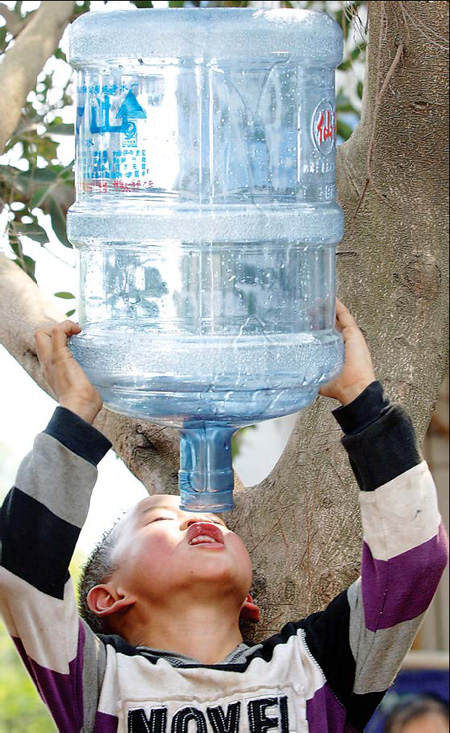Water crisis brings struggle for survival
Niu Siwei's sense of unease grows each time he hears his students cough.
After eight months with no rain, the village school where he teaches in Nanhua County of Chuxiong, a Yi ethnic prefecture in the southwestern Yunnan Province, has been using water from a local fish pond for cooking.
 |
|
A boy squeezes the last drop from a mineral water bottle in Wulong county, Chongqing, on Saturday. The area is suffering from one of the severest droughts in history. |
The feculent water is sterilized with bleach powder, so the meals for the 192 students, aged 7 to 12, always have a strong smell of the chemical.
"At the beginning, the cook believed the more bleach powder he used, the safer the water would be," said Niu. "Once he put 10 grams in 100 kg of water, amost 10 times the safe amount."
Last week, some thirsty students took a few mouthfuls of unprocessed pond water, and came down with vomiting and diarrhea.
The once-in-a-century drought that has left almost 20 million people thirsty in China's southwestern localities, including Yunnan, Guizhou, Guangxi, Sichuan and Chongqing, has aroused widespread concern.
As a result, donations of drinking water are arriving.
The donated water, however, averages only 600 ml a day for each student, less than half of the daily per capita requirement.
Three times a week, Niu takes his students to fetch water from a pond 1,000 meters from school. "Even the girls carry about their own weight in water, and a two-way trip takes only 15 minutes."
But the pond, too, has little water left.
Chuxiong, one of the poorest areas in China, is not alone.
In Qujing City, many villagers have to wait 48 hours before they can fetch a bucket of water at the few sources still in service.
Every day, 5-year-old Liao Mingbo joins the queue, carrying 2.5 kg each time. "It's not heavy. I've been doing this for many months."
Liao's fellow villagers in Huize County must walk about two and a half hours to get to a river for water.
"For generations, we relied on rain for drinking water," said villager Wang Zhengyi. "But our water cellars dried up months ago. We're busy carrying river water every day to survive. Who cares about the crops?"
The drought has damaged at least 3 million hectares of cropland in Yunnan Province, according to figures released by the national flood prevention and drought relief headquarters in Beijing. Many peasants complain all their wheat, beans and vegetables have died.
The drought has cut the province's power generation capacity by 30 percent, as it largely relies on hydropower, and water flow in the Lancang River, Asia's third longest, was down by half compared with last year.
If the drought continues, almost a quarter of the local population will suffer drinking water shortages by May, said Zhou Yunlong, chief of water resources in Yunnan.
The province has a population of 45.5 million, according to the most recent census in 2008.
 0
0 






